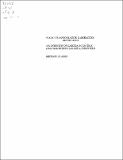The Airline Operation Control Centre : an overview of Garuda's Operation Control (EM) at Cengkereng Jakarta, Indonesia : final report to PT Garuda Indonesia
Author(s)
Clarke, Michael D. D.; Naryadi, Yudi.
DownloadFTL_R_1995_09.pdf (1.869Mb)
Alternative title
Overview of Garuda's Operation Control (EM) at Cengkereng Jakarta, Indonesia
Other Contributors
Massachusetts Institute of Technology. Flight Transportation Laboratory
Metadata
Show full item recordAbstract
Introduction: Airline operations are generally handled in two phases, strategic and tactical. Strategic operations are concerned with schedule planning. Given the desired schedule of services to be offered to passengers (called the Schedule of Services) established by the Commercial/ Marketing department, the Operations group generates the Nominal Operational Schedule (NOS) for the airline's resources such aircraft rotations and crew rotations, and then assigns tail numbers, and individual crew members to a given flight. These activities constitute the schedule generation and resource allocation phases of the scheduling process. They are carried out by various groups which support the development of the planned schedule for all airline resources. Given these resource schedules, the tactical side of the Operations group is responsible for the final stage of the scheduling process: Execution Scheduling. Execution scheduling is the process of executing the system resource schedules on a daily basis. This involves three main activities: executing the pre-planned schedules, updating the schedules for minor operational deviations, and rerouting for irregular operations. The tactical operations of a regular scheduled air carrier is usually under the 24 hour/day control of a central organization often referred to as the Airline Operational Control Center AOCC. This chapter presents a summary of a typical AOCC, outlining its organization, primary activities within the airline, and operational facilities. The facilities and personnel of a particular AOCC will vary considerably depending on the type and size of the airline. AOCC centers can range from a single controller/dispatcher on duty to several dispatchers and hundreds of other personnel handling flights throughout the carrier's entire global network. During the process of operation control, the AOCC is supported by the Maintenance Operations Control Center (MOCC) which controls aircraft maintenance activities, and various Station Operations Control Centers (SOCC) which control station resources (gates, refuelers, catering, ramp handling, and passenger handling facilities). Operations Control Centers are usually linked to the Aeronautical Radio Inc. (ARINC) and the Societe International Telecommunications Aeronautiques (SITA) networks to send and receive teletype/telex messages. Communications with maintenance and engineering, customer service, and airport services are maintained to facilitate prompt contact with the appropriate personnel. Teletype, telex, facsimile, telephone, leased lines, and public data networks combine to provide an effective medium of collecting information and communicating revised operational plans developed by the AOCC center. In some cases, the AOCC has communications systems connected to VHF, HF and Satcom radio links, air traffic control centers, and other relevant locations, allowing them to effectively gather and disseminate information instantaneously.
Description
October 16, 1995 Includes bibliographical references
Date issued
1995Publisher
[Cambridge, Mass. : Massachusetts Institute of Technology, Flight Transportation Laboratory, 1995]
Other identifiers
663469569
Series/Report no.
FTL report (Massachusetts Institute of Technology. Flight Transportation Laboratory) ; R95-9
Keywords
Airport control towers